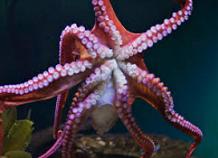 The adjective cephalopod is used in the field of zoology to describe a marine mollusk that has a sac with an opening, through which its head emerges. In cephalopods, the head is clearly differentiated from the body and is surrounded by tentacles with suction cups .
The adjective cephalopod is used in the field of zoology to describe a marine mollusk that has a sac with an opening, through which its head emerges. In cephalopods, the head is clearly differentiated from the body and is surrounded by tentacles with suction cups .
It is possible to recognize nearly seven hundred species of these invertebrate animals that belong to the group of cephalopods. Among them we can name squid and octopus .
Beyond the differences between species , cephalopods share the peculiarity of having an organ known as the foot next to their head. The foot is divided into a variable number of tentacles.
In cephalopods the shell generally disappears, becomes internal or shrinks. Another peculiarity of cephalopods is that they have chromatophores , cells that are found in their mantle and allow them to modify their color to achieve mimicry with their environment and communicate with other individuals of the same species.
The secretion of ink and a very flexible body are other properties that cephalopods have, in this case with the aim of hiding from their predators. To hunt, these animals use highly developed eyes that give them night vision.
It is important to mention that many cephalopods are part of the human diet. Galician-style octopus , for example, is a very popular dish that features octopus meat with olive oil, salt, and paprika. Squid, for its part, can be eaten fried, battered, stewed and in other ways. Curiously, there was a time when these animals were at the top of the sea's food chains.
Evolution of cephalopods
 The separation between cephalopods and other mollusks took place approximately 500 million years ago , when the first mollusks appeared that had the ability to fill some parts of their shell with gas to float. Currently, certain species of cephalopods retain this ability, and at the time it gave them the possibility of going beyond the bottom of the sea, where until then they had no other option, and thus access new trophic routes closer to the surface. .
The separation between cephalopods and other mollusks took place approximately 500 million years ago , when the first mollusks appeared that had the ability to fill some parts of their shell with gas to float. Currently, certain species of cephalopods retain this ability, and at the time it gave them the possibility of going beyond the bottom of the sea, where until then they had no other option, and thus access new trophic routes closer to the surface. .
According to the most recent discoveries regarding their evolution, it is estimated that the origin of cephalopods is much earlier than previously believed. The first, who still inhabited areas close to the coast, had to accept a movement towards the interior of the sea by more advanced living beings, such as marine reptiles and fish.
Another obstacle that the first cephalopods had to face was the impossibility of descending to the seabed from the surface, because their shell could not withstand the pressure . As generations with smaller shells emerged, it was possible to get closer and closer to the bottom, something that in turn had a positive impact on their diet.
As expected, natural selection leaned in favor of the latter. As time went by, the shell of cephalopods shrank until it became internal or disappeared. Around 470 million years ago, coleoids (a subclass of cephalopod mollusks that currently include octopuses, squid, and cuttlefish, among others) already appeared, and there were still some cephalopods that have already become extinct.
According to the theory of the meteorite that impacted our planet 65 million years ago , a large part of the cephalopods became extinct at that time. Ammonites are a clear example of mollusks that ceased to exist at that time. The only survivors were the nautiloids and coleoids.
